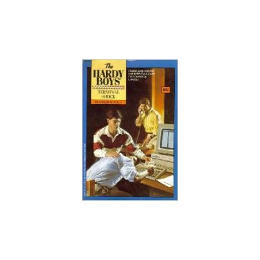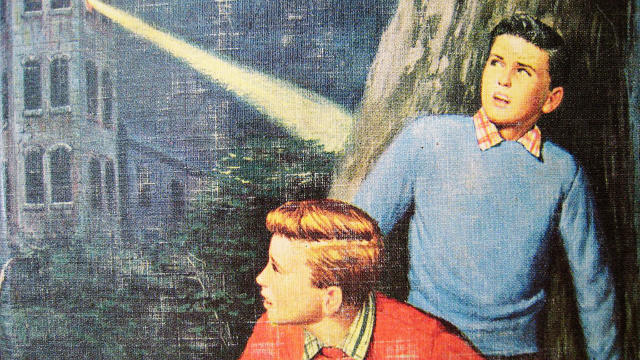Late last year, while working on a story about the early days of Match.com, I heard a lot of reminiscing about the days just before the web took off.
Match's early users and employees shared memories of when they first used their computers to dial up to the outside world—to CompuServe, to the Bay Area's Whole Earth 'Lectronic Link , or to one of the other local bulletin board systems that dotted the country in the late '80s and early '90s.
I was a little too young to have really experienced the BBS era, and I was a little too embarrassed to admit where I first learned that people could use computers to talk to each other: from an oddly futuristic Hardy Boys book I read somewhere around the fourth grade.
But a quick, nostalgic Amazon search turned up the book in question, available for just a penny (plus shipping). Terminal Shock, I rediscovered a few days later, introduced the crime-solving teen brothers and their impressionable fans to designer drugs, top-secret superconducting microchips, and evidence buried in encrypted emails, somehow all within a few square miles of the boys' suburban hometown.

In between bursts of G-rated sibling rivalry—the phrase "stick a sock in it" appears by the fourth page—boy detectives Frank and Joe Hardy even wrestle with mass email surveillance, years before high-speed home Internet.
"Glad to hear you've got that AT clone up and running, with that 4800 baud modem," the boys read in an email from a friend. "Bet that 386 processor really screams!"
All that modem talk is just so much gobbledygook to Joe, the younger Hardy. Pages later, the brothers receive an urgent instant message from the operator of their hometown bulletin board. They'll soon find him in a coma, the victim of a genetically engineered "designer poison" doctors say will kill him within a week. The main apparent clue is the email archive for the system, contained on an encrypted floppy disk. When the boy detectives uncover the password to unlock the disk, they continue their investigation in a way that seems oddly topical—and more than a little disturbing—today: reading through each user's private email inbox on the system until they find a clue.
Looking back, the plot line seems not only oddly futuristic for 1990, when the World Wide Web was in its infancy, but also atypically dark for a children's mystery series I generally remember as the literary equivalent of Scooby-Doo.
So I set out to learn how the teen detectives came to take on the not-quite-Net so early, and how its author might feel today about the Hardys' mass-surveillance approach to crime solving.

Like all the Hardy Boys books since the series' debut in the 1920s, Terminal Shock was published under the pen name Franklin W. Dixon. Dixon never really existed—the series was originally written by Canadian journalist Leslie McFarlane under the direction of editor Edward Stratemeyer, who also created the Nancy Drew, Bobbsey Twins, and Tom Swift series at around the same time. (Another Stratemeyer series, called The Motion Picture Chums, has since been studied for its depiction of the early film industry, at a time when movie studios and theaters were the tech startups of the day.)
In the 1980s, the Hardy Boys and Nancy Drew books were being published by Simon & Schuster and written by a new generation of Franklin Dixons. I contacted Simon & Schuster to see if they could put me in touch with the ghostwriter, but a spokeswoman for the publisher wasn't able to locate Hardy Boys records pre-1998. She did mention, though, that the books were put together by New York book packaging firm Mega-Books Inc.
New York state records indicated the company hadn't been active in a decade, but I reached out to the former Mega-Books executives I could locate online. A few weeks later, I got a call from Christopher Lampton, the author of Terminal Shock.
Lampton says he was one of a number of freelancers recruited by Mega-Books editor William McCay to modernize the series for a new generation of readers. "He didn't want to do your father's Hardy Boys," says Lampton, who'd go on to write 11 books for the series.
Lampton had previously written science and technology books for children and adults, as well as some science fiction. He'd even ghostwritten for a Stratemeyer-style series called The Thorne Twins, whose protagonists solved mysteries in accordance with Christian principles. Working with McKay, Lampton says he drew on his own background in science, as well as some experience working in radio and television, for Hardy Boys ideas.

One of his books, called Danger on the Air, is set at a local TV station; another, called Rock 'n Roll Renegades, saw Joe as a disc jockey facing off against nefarious pirate radio broadcasters.
"To tell you the truth, I used it as an excuse to write about all these corny ideas," says Lampton. "Hardy Boys—what a perfect excuse to write about all these ideas I had floating around my head since I was a teenager."
Lampton, who says he's recently focused more on technical and nonfiction writing, started using CompuServe in 1983 and thought that his young readers would enjoy a book set in the digital world.
"Even then, the joke was that kids knew more about computers than adults," he says. "I tried to write about the technology that would be available at the time, because I knew a lot of kids would know about that."
And the plot fit the guidelines of Mega-Books's "series Bible," which Lampton says depicted the elder Frank as "more willing to use his brains" and tools like computers. "We were very careful never to portray them exactly as geeks," he recalls.
Throughout the book, as the boys solve the mystery, Frank pauses frequently to explain tech terminology to technophobic Joe and, of course, to less-than-savvy young '90s readers like myself. "It's kind of like recording tape, except that it's round and flat instead of long and skinny," he says of a floppy disk.
"I assumed some of the audience would relate to that, since some of the people who were running these local bulletin boards in my area were kids," says Lampton.
The wholesome Hardy formula sometimes meshes awkwardly with the book's dark subject matter: At one point, the boys meet the comatose poisoning victim's girlfriend for pizza at "a favorite hangout for Bayport teenagers." She declines a second pepperoni slice, saying she's too worried to have much appetite. "I had to stretch this thing out to the length of a book," Lampton points out, not unfairly. "I'm glad I had the girlfriend make the comment that it was inappropriate."
The technical details were mostly accurate, he recalls, designed to be just slightly ahead of the book's time. The major miscalculation he remembers: the emailed boast about a 4800-baud modem. Modem technology mostly went straight from 2400 baud, or bits per second, to 9600, with few devices sending data at the rate in between, he recalls.
And while indiscriminate warrantless email snooping now feels out of character for the wholesome Hardy Boys, local BBS email was a much less personal medium in 1990 than our email accounts are today, Lampton says.
"Let's put it this way: Hillary Clinton wouldn't be sending emails to one of her embassies over one of these systems," he says.